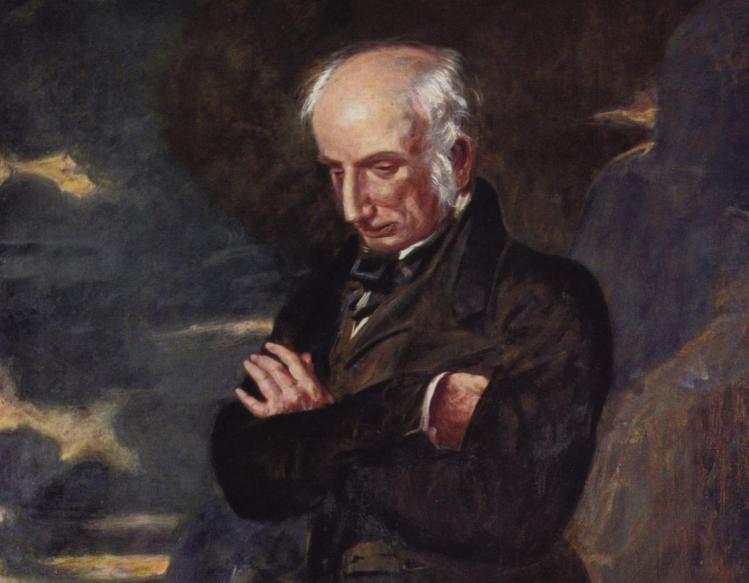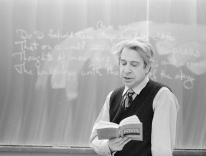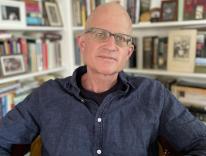
Robert D. Richardson, one of America’s best intellectual biographers, died on June 16 at the age of eighty-four. Richardson’s three major works—Henry Thoreau: A Life of the Mind (1986); Emerson: The Mind on Fire (1995); and William James: In the Maelstrom of American Modernism (2006)—are models of the genre. Taken in total, they capture not just the lives and minds of his subjects but the life and mind of America itself: its blending of the spiritual and the pragmatic, the radically empiricist and the radically transcendental.
Another excellent biographer, Hermione Lee, has said that “the reader’s first question of the biographer is always going to be, what was she, or he, like? Other questions (like why, or how do you know, or do we approve, or does it matter?) may follow. But ‘likeness’ must be there.” Likeness is certainly there in Richardson’s three portraits. There is the sometimes grouchy, always paradoxical Thoreau, a man “very much fixed in his ways” who “was capable of saying, with blithe and utter injustice, that he had ‘yet to hear the first syllable of valuable or even earnest advice’ from his seniors, yet [who] could turn around and use Emerson as an oracle, opening his printed works at random and reading the first sentence his eye lit upon, a sortes Emersonianae.” There’s the impetuous, lovely Emerson himself, who “lived for ideas, but [who] did so with the reckless, headlong ardor of a lover,” whose “passion for friendship”—with Thoreau, with his wife Ellen, with many, many others—gave “new depth and a greater ease of access to his own best thought.”
And finally, there’s the endlessly energetic James, who was “astonishingly, even alarmingly, open to new experiences,” climbing mountains and attending séances and writing books up until his death. You want to know what James was like? Try this paragraph, which comes right after Richardson has quoted from an italics-laden passage of James’s late prose:
It is impossible, after reading James for any length of time, to refrain from using italics oneself. But even italics fail to do justice to this magnificent outburst, the last stand of William James for the spirit of man. What can one say about the philosophical bravado, the cosmic effrontery, the sheer panache of this ailing philosopher with one foot in the grave talking down the second law of thermodynamics? It is a scene fit to set alongside the death of Socrates. The matchless incandescent spirit of the man!
Forget the ideal of scholarly objectivity. A biographer damn well better love his or her subject. It should be a complicated form of love, not unthinking, not idealizing. But it should be love nonetheless. Richardson loved Thoreau. He loved Emerson. And he loved James. What fruits that critical love has borne.
Henry Thoreau: A Life of the Mind
University of California Press, 464 pp., $31.95
Emerson: A Mind on Fire
University of California Press, 684 pp., $33.95
William James: In the Maelstrom of American Modernism
Mariner Books, 656 pp., $18.95
Here’s a conundrum for the biographer. What do you do if you find yourself enchanted by one stretch of your subject’s life—the creative outburst of a young poet, for example—and bored stiff by another stretch—say, the long rise or fall, depending on how you look at it, into venerability?
If you’re Jonathan Bate in Radical Wordsworth: The Poet Who Changed the World, you first admit the problem upfront. In his apologia of a preface, Bate says he didn’t want his book to be too long. Recent biographies, he complains, have “reproduce[d] one of Wordsworth’s faults, namely the prolixity that was mocked by Lord Byron.” He then lists some of the conundrums he wants his own work to face up to: “How the first half of Wordsworth’s life was such an extraordinary adventure and the second half so dull; why the poetry of the first half is so memorable, that of the second so forgettable.” In the exciting first half of his life, you have Wordsworth getting caught up in the French Revolution (he initially supported it), Wordsworth having a child out of wedlock (in a soap-opera twist, the mother, Anette Vallon, was a royalist), Wordsworth writing the Lyrical Ballads with Samuel Taylor Coleridge and finishing a draft of The Prelude, his epic on the growth of the poet’s mind. As for the boring second half, there’s a fall into conservative politics, some passive-aggressive feuds with Coleridge, and the endlessly unfinished poem The Recluse. Not exactly the stuff of high drama.
Using a mountaineering metaphor (like William James, Wordsworth loved a good climb), Bate describes Wordsworth’s first thirty-six years as an “arduous but exhilarating ascent” followed by “forty-four years of crawling decline.” Bate writes that “[t]he second half of Wordsworth’s life was the longest, dullest decline in literary history,” and his workaround is to paraglide down the slope. Those first thirty-six years get about 350 pages, the remaining forty-four only about a hundred, followed by a coda tracing Wordsworth’s lasting influence on everything from the environmental and conservation movements to William James and Sigmund Freud. Wordsworth famously structured The Prelude around “spots of time”: moments from our past that form our selves and offer, as the poem has it, “a fructifying virtue.” Bate does the same in his light-footed biography, gracefully hopping from essential moment to essential moment, moving around time rather than sequentially through it.
Bate begins at the highest of heights, on Christmas 1806, with Wordsworth reading a draft of The Prelude to his sister, Dorothy, and his friend Coleridge. The poem “was and remains the original, the exemplary autobiographia literaria,” Bate writes, marking “an epoch in the history of the modern self,” turning the stateliness of blank verse towards the suppleness of the mind and memory at work. The book then circles back, talking about Wordsworth’s sorrow-filled childhood (his mother died when he was seven, his father when he was thirteen), his time traveling in France during the Revolution, his friendships with Coleridge and the essayist Charles Lamb, all leading up to this Yuletide reading. In a letter to his patron, Wordsworth described The Prelude as “a thing unprecedented in literary history,” bragging (admitting?) that it was almost impossible “that a man should talk so much about himself.” It’s no exaggeration to say that much of twentieth- and twenty-first-century poetry is a footnote to Wordsworth. The Prelude expressed a series of equivalences—between selfhood and memory and poetry—that have shaped, either through affiliation or differentiation, almost everything that has come after. Bate is right to describe Wordsworth as radical. The roots of modern poetic selfhood lie in the Lake Country with the Lake Poet.
Does Bate offer an answer to Hermione Lee’s primary question for the biographer: What was Wordsworth like? For the most part, yes. He’s less gifted at vivid portraiture than Richardson, but he offers a rich sense of context—the social, political, and familial worlds in which Wordsworth moved. There are excellent quotations from Wordsworth’s friends (Charles Lamb teases the poet at a dinner party: “Now you old lake poet, you rascally poet, why do you call Voltaire dull?”) and his frenemies (Byron on his precursor: “Wordsworth—stupendous genius! Damned fool!”). Wordsworth’s father served as an earl’s legal representative, which often meant standing voters drinks at the local pub. One 1774 bill came out to “just a few shillings short of £200, for ‘Victuals and Liquor consumed during the course of the poll.’ That is about £30,000 or $40,000 in today’s money.” That’s a lot of lukewarm ale.
Given Bate’s sense of the anticlimax of Wordsworth’s later life, it’s perhaps inevitable that his own book sags in its last pages, especially when he discusses the poet’s legacy for later writers. Much of this influence is well known (George Eliot’s debts to Wordsworth can be seen in all of her novels), and some of it is thinly sketched. He admits that the route from Wordsworth to Freud is “circuitous”: Romain Rolland loved Wordsworth’s mysticism; Rolland wrote to Freud about religious experience and “oceanic feeling”; Freud wrote about the “oceanic feeling” in Civilization and its Discontents. The vitality of Wordsworth’s life and work lay in his earlier years; the considerable vitality of this biography lies in its earlier pages, too.
Radical Wordsworth: The Poet Who Changed the World
Yale University Press, 608 pp., $35.00
Wordsworth mined his own life for poetry, and he wasn’t above mining other people’s lives, too. His beloved sister, Dorothy, frequently appears in his poems—as well she should, given how crucial her love, conversation, and journals were to her brother’s own writing. But Wordsworth never included, at least in unencoded form, his love affair with Annette or the birth of their daughter Caroline. Surely this omission was in part to avoid scandal to his own name. But just as surely it was to avoid harm to a woman he loved and a child whose life he largely missed. Art just isn’t worth that much.
That last sentence comes from a 1972 letter Elizabeth Bishop wrote to her friend Robert Lowell, and it gives us her response to one of the great violations of twentieth-century literary history. Lowell had just sent Bishop the manuscript of The Dolphin: a book of sonnets that charts the end of Lowell’s marriage to the writer Elizabeth Hardwick and the beginnings of his affair, and eventual marriage, to the writer Caroline Blackwood. It wasn’t surprising that Lowell was writing from life. If Wordsworth created, in Keats’s memorable phrase, the “egotistical sublime” of Romantic poetry, then Lowell helped to found confessionalism—an even more egotistical, if less sublime, style of poetry that doubled down on self-exposure. But The Dolphin exposed not just Lowell’s abandonment of his wife and child in the United States for a new life in England. It also exposed Hardwick—not just by talking about her experiences of abjection but by quoting from the letters she wrote exposing that abjection.
Quoted and transformed, actually, since Lowell tweaked some of Hardwick’s language and altered the chronology of the affair. In her stern, smart letter, Bishop points out that Lowell has committed a double violation. “Lizzie is not dead,” she writes, and quoting from her at her most wounded betrays a woman who Lowell still, in some way or another, loved. Furthermore, Bishop argues, in its transformations Lowell’s book mixes up fact and fiction in a way that is indefensible. The reader would pruriently have access to Hardwick’s most personal feelings—and the reader would impute language and feeling to Hardwick that was really Lowell’s own poeticizing. For Bishop, the book, though it “contains magnificent poetry,” fails on both aesthetic and ethical grounds.
Despite this discouragement from a trusted friend, Lowell published The Dolphin anyway. (Confessional poets gonna confess.) Hardwick threatened legal action; the book won the Pulitzer Prize. For a long time, we didn’t have access to most of the actual letters Hardwick wrote Lowell from the start of the affair in 1970 to Lowell’s death in 1977. Now, in an edition published by Farrar, Straus and Giroux and edited and introduced by the poet and critic Saskia Hamilton, we have this remarkable correspondence in the round. (FSG has also published a new version of The Dolphin, complete with drafts and revisions, also edited by Hamilton.)
The Dolphin Letters, 1970-1979: Elizabeth Hardwick, Robert Lowell, and Their Circle includes the Hardwick-Lowell correspondence, as well as letters to and from Bishop, Mary McCarthy, and others. Lowell can be charming (there’s a reason so many writers fell in love with him) but he also can be monstrously cruel. On May 5, 1970, by which time Lowell’s affair with Blackwood had begun, he wrote to the unsuspecting Hardwick—praising her for the “delightful letters you write,” including a drawing for their daughter, Harriet, and begging confusion over tax issues. (This is a recurring topic: Lowell depended upon Hardwick to take care of the family finances, as well as the household, their child, and much else, even after they’d separated.) Several months later, after Hardwick had learned of the betrayal, Lowell opened a letter with the casual, “I wonder if we couldn’t make it up?” Soon thereafter he retracted the offer of rapprochement and asked Hardwick to organize the sale of his papers to Harvard. By January 1971, Hardwick faced up to reality: “My financial situation is desperate and is going to be for the rest of my life. But I will manage that; the taxes for the coming year obsess me.” Lowell responded unhelpfully (“I hadn’t thought we had gained so much…. The government scoops us like a steamshovel”), then in a subsequent letter mused on the past (“I miss your old guiding and even chiding hand”), all the while living with Blackwood, who was by then pregnant with their son.
Lowell’s entitlement is startling, even by midcentury standards. Just as startling is the composure with which Hardwick meets this impossible situation. She took care of Harriet and the tax bills and everything else. She wrote brilliant essays for the New York Review of Books; she worked on her fictional masterpiece, Sleepless Nights; she taught at Barnard. In her letters, Hardwick makes her pain clear but also indicates that she won’t be defeated by it: “I have never tried to deny my grief and pain and my love for you. For me at least the amputation will probably always hurt, but I am resigned to that.” Two years after he left her, Hardwick is still talking her helpless ex through finances: “I cannot do anything further about your filing a tax return for 1972. This is a thing that will go on until you die and so I guess this year is the time to get in touch with it.” Writing to Bishop, Hardwick reflected on reading The Dolphin: “In the end it doesn’t matter whether these things are ‘true’ or ‘unfavorable’ in the usual sense; you just can’t help but weep with pain as you are tossed in someone’s work, especially creative work.” Yet her continued care for Lowell is remarkable. The two eventually reconciled, though Lowell remained married to Blackwood. “I can’t find the words,” he writes years after the publication of The Dolphin, “or maybe the style to say how comforting and enjoyable your visit was.” In the last letter from Hardwick to Lowell published here, she writes from Maine. It’s 1976. She mentions the Democratic Convention and their daughter: “Harriet is studying typing, finishing term papers, swimming in the Columbia indoor pool.” There’s a stylistic intimacy, an equitable warmth towards the man who so harmed her, that is itself a moral achievement:
Let’s see—I always have a thousand things to share with you, but how the letter writing energy seems to diminish with the years. I suppose that if I had a period in a pension could wake up and rush to it, but it is hard to find the communicating tranquility in one’s own house with the chores standing there like hungry cats, waiting, calling out.
Lowell was an often great poet. Hardwick was arguably a greater writer, and certainly more consistently great. (Of The Dolphin, Hardwick wrote, “I cannot understand how three years of work could have left so many fatuities, indiscretions, bad lines still there on the page.” I’m with you, Lizzie.) There is great suffering in The Dolphin Letters. There is also, in Hardwick’s correspondence particularly, abundant grace.
The Dolphin Letters, 1970-1979: Elizabeth Hardwick, Robert Lowell, and Their Circle
Edited by Saskia Hamilton
Farrar, Straus and Giroux, 560 pp., $50.00
The Dolphin: Two Version, 1972-1973
Robert Lowell
Edited by Saskia Hamilton
Farrar, Straus and Giroux, 224 pp., $18.00
Please email comments to [email protected] and join the conversation on our Facebook page.
Previous Story
Minds Stocked Only with Opinions
Next Story
A Church That Is Poor?


